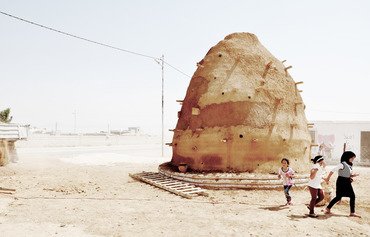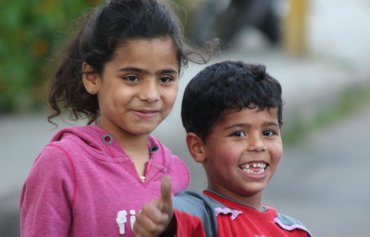Inside Jordan's sprawling Zaatari refugee camp, a team of citizen journalists have been producing a magazine that gives voice to Syrian refugees.
"The Road", produced by volunteers and distributed free to camp residents, tells the story of the refugee experience in the words of those who have experienced it firsthand.
The magazine, launched in May 2014 by international nongovernmental organisation Japanese Emergency (JEN) with the support of UNICEF, features the work of around 150 citizen journalists between the ages of 14 and 27.
The journalists roam the camp in dark blue vests, reporting on many aspects of life in Zaatari.
![Citizen journalists at Jordan's Zaatari camp receive a training on video editing. [Photo courtesy of The Road]](/cnmi_am/images/2017/11/01/10177-Zaatari-road-magazine-600_384.jpg)
Citizen journalists at Jordan's Zaatari camp receive a training on video editing. [Photo courtesy of The Road]
"The idea first started as we wanted to let Syrian refugees express what they are feeling," said JEN Jordan head Cyril Cappai.
News about life at the camp is typically transmitted to the public via international organisations, not "from the people themselves", he said.
"In The Road, it is the voice of the people."
"It all started four years ago with a group of seven male volunteers," said Huda Sarhan, The Road's editor-in-chief. "They produced an eight-page magazine [covering issues] that concerned them, as refugees."
Within a few years, the number of volunteers increased, women started to join the initiative and the magazine grew in size and circulation, creating a buzz in the community, she told Al-Mashareq.
At present, 20,000 Arabic language copies are distributed free of charge throughout the camp, she said, and English copies are handed out to the various aid organisations working there.
The 24-page magazine features stories that are of interest to refugees or tell their stories -- their flight from Syria and their efforts to adapt to their new situation inside the camp.
'Nobody can write about us'
Abeer al-Eid, 25, is one of the magazine's female journalists.
She joined the team as soon as she heard about The Road, she told Al-Mashareq, and began writing about humanitarian issues inside the camp.
She also enjoys writing poems about her homeland, and her desire to return.
"I have always dreamed of becoming a journalist," she said. "I am currently living this dream in the camp."
Another journalist, who goes by the name Mohammad, told Al-Mashareq he writes to convey the voice of his people to the world.
"Nobody can write about us," he said. "You cannot be accurate in writing about us, as we are the ones who have been through it all alone."
The Syrian people are creative, he said: "I want to show this to the world."
Mohammad contributes to the section of the magazine that highlights refugee success stories and their creativity in adapting to life inside the camp.
As it has grown, the magazine now includes stories contributed by Syrian refugees who live outside Zaatari as well.
The Road also addresses social issues, avoiding flashpoint topics such as politics and religion, and must be reviewed and approved by the Syrian Refugee Affairs Directorate (SRAD) in Jordan before publication.
Challenges facing the magazine
Teaching the volunteer writers the basics of journalism was challenging at first, Sarhan said.
"At the beginning, their writing required a lot of editing, so we had to start from zero," she said.
The magazine's volunteers have since received training workshops in journalism, report writing, photography and film, she said.
"We take advantage of every journalist or photographer who visits the Zaatari camp to come and give the journalists a session," Sarhan said, even if they are able to provide just a short lesson.
According to Cappai, funding is one of the magazine's biggest challenges.
The Road team is entirely comprised of volunteers, he said, adding that the designer is a Syrian refugee in Copenhagen who volunteered to help.
The journalists are not paid, yet they are provided with laptops to use at an office inside the camp, where the editorial meetings are held.
Thanks to the hard work of its volunteer journalists, the magazine is gaining popularity among the camp's roughly 79,000 residents, along with international recognition, and helping to tell the world the story of the refugee experience.

![Trainers pose with the editorial staff of The Road magazine, produced by Syrian refugees living in Jordan's Zaatari camp. [Photo courtesy of The Road]](/cnmi_am/images/2017/11/01/10173-Jordan-Zaatari-camp-600_384.jpg)







Peace be upon you! I’m Mohammed al-Rubaei. I’m a volunteer at al-Tariq magazine. In the name of all team members, I thank all those who worked on this beautiful gesture. May God bless you!
Reply1 Comment(s)